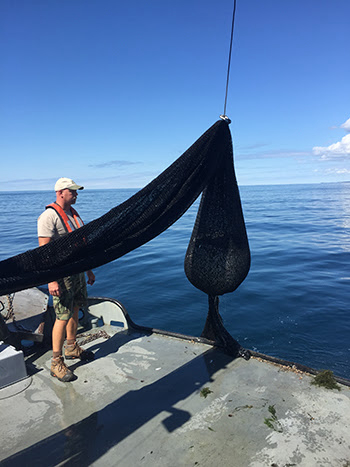Indiana to temporarily suspend Lake Michigan Chinook salmon stocking
The Indiana DNR will temporarily cease stocking Chinook salmon in Lake Michigan in 2017 out of concern that there isn’t enough food in the lake.
Research has shown that the amount of prey fish in Lake Michigan are at historic lows. The decision to reduce Chinook salmon stocking in Indiana waters is part of a multi-state plan to restore balance to the lake’s ecosystem and preserve its multi-billion dollar sport fishery.
Biologists hope the lakewide stocking reduction will allow populations of prey fish, such as alewives, to recover.
The Lake Michigan Committee, the group responsible for cooperatively managing Lake Michigan’s fisheries, recently announced a 62 percent reduction in lakewide Chinook salmon stocking to take effect in spring 2017. The committee is made up of representatives from Indiana, Illinois, Michigan and Wisconsin and the Chippewa Ottawa Resource Authority fishery agencies.
Since 2013, Indiana has stocked 200,000 chinooks annually. The lakewide stocking plan reduces Indiana’s Chinook quota to 45,000 chinooks beginning in 2017. However, given low fall Chinook returns and difficulty obtaining Chinook eggs from out-of-state partners, the DNR’s Lake Michigan Management Team decided to suspend Chinook stocking altogether.
In the interim, the DNR will use the free hatchery space to rear an additional 45,000 to 50,000 Skamania steelhead trout to yearling stage for stocking in Lake Michigan, according to Jeremy Price, north region fisheries supervisor with the DNR Division of Fish & Wildlife. Price is also the state’s representative to the Lake Michigan Committee.
“We want to consistently give anglers the best fishing opportunities possible,” Price said. “These steelhead will survive at much higher rates than Chinook, rely less on alewives for food, offer fishing opportunities for boat, pier and stream anglers alike, and give us complete control of our production cycle.”
The interim plan likely will be in place for at least three years while biologists evaluate how alewife populations respond.
“If prey fish abundance recovers to acceptable levels, we plan to add chinook back into our stocking mix,” Price said.
Indiana’s Lake Michigan fisheries biologist Brian Breidert said suspending Chinook stocking was “certainly not a desired outcome.” But he added that nearly 70 percent of Chinooks that boat anglers catch in Indiana are wild, not stocked.
“So we will continue to have an open-water Chinook fishery in Indiana,” Breidert said.
The latest Chinook reduction comes on the heels of a lakewide stocking cut implemented in 2013. That effort saw success, but prey fish recovery was hampered due to poor alewife spawns in consecutive years.
The committee also has slated a cut of 550,000 lake trout to take effect this fall.




